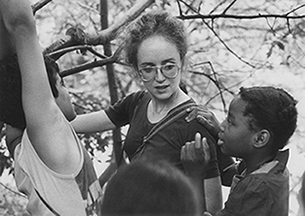September 30th, 2022
Budding Poets in the Park
During what turned out to be my apprenticeship between 1976 and 1979 for the founding of a more lasting public-private park partnership that would be named Central Park Conservancy, I was the director of the Central Park Task Force, a small not-for-profit organization with a novel mission. Housed in two small rooms on the bottom floor of the Arsenal, the repurposed 1850s military building at the 64th and Fifth Avenue entrance to the park that serves as the New York City Department of Parks and Recreation’s headquarters, the Task Force attempted to raise funds and provide oversight for educational programs and volunteer activities such as the replanting of the then-unkempt flower beds in the park’s Conservatory and Shakespeare gardens. It also became the vehicle for the creation of a summer-jobs-for-youths program in which small groups of high-school students were supervised by young adults I had recruited either because of their practical horticultural knowledge or gardening experience.
 One such supervisor was the poet Sandra Alcosser, who was at the time a member of the Green Gorillas, founded in 1973 as a vacant-lots / abandoned-buildings beautification movement on the then derelict Lower East Side. While this green-thumb volunteer organization was becoming the progenitor of the community garden movement in New York City.
One such supervisor was the poet Sandra Alcosser, who was at the time a member of the Green Gorillas, founded in 1973 as a vacant-lots / abandoned-buildings beautification movement on the then derelict Lower East Side. While this green-thumb volunteer organization was becoming the progenitor of the community garden movement in New York City.
Sandy had by this time distinguished herself as a published poet and would go on to become a professor of poetry, fiction, and feminist poetics at San Diego State University where she currently teaches while also continuing her affiliations with other institutions of higher learning where the art of writing poetry is part of a creative writing curriculum.
Luckily for the Central Park Task Force’s handful of high school-age summer interns whose work program Sandy had been hired to create and oversee, they would be the beneficiaries of her ability to demonstrate how observations of random objects found in nature and touched by hands as well as eyes can elicit hidden meanings that bloom into words.
As a rule, lunchtime beside one of the park’s rock outcrops was used not only as a break from work but also as poetry-writing time. As I made a habit of walking about in the park checking on the various groups of summer interns at this hour, I would often stop and sit down on the grass and look over the shoulders of the kids in Sandy’s designated outdoor classroom.
I wish that the folder I found in my diligent attic cleaning this summer had yielded more than the sampling below, but it still gives me pleasure to publish electronically here the long-hidden poems that have remained. I like the fact that they express Sandy’s pedagogical hold-and touch sensory approach to eliciting the kind of metaphorically expressed meanings that are the soul of poetry.
Poems from Sandra Alcosser’s Central Park Task Force Poetry Workshop
I am a rock that stops at all places
And all want to break me. But I do not break
Anyone. Some take me to sell me. They
Like my brown color.
But I am not food to be sold.
All I am is a poor stone
That jumps from hand to hand.
Pedro Mejia
_
My thoughts enter a rock
And it becomes hollow. The waves
Of the river crash against the rock
And the fish touch it. There is a
Silence inside us like a library. A silence of
Of serpents. Inside the rock the glow
is marvelous.
Pedro Mejia
_
I concentrate and slowly enter inside
A stone. I see mountains around me.
Where I am is clear. The waves of the
Sea go over my rock. Where I am is
Is wonderful with marks. The stone
Is left with marks of shells and snails
from the sea.
My thoughts enter a rock
And it becomes hollow. The waves
Of the river crash against the rock
And the fish touch it. There is a
Silence inside us like a library. A silence of
Of serpents. Inside the rock the glow
is marvelous.
Pedro Mejia
_
I concentrate and slowly enter inside
A stone. I see mountains around me.
Where I am is clear. The waves of the
Sea go over my rock. Where I am is
Is wonderful with marks. The stone
Is left with marks of shells and snails
from the sea.
Cesar Viven
Share
